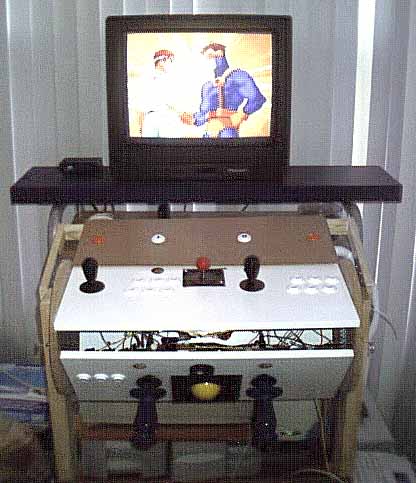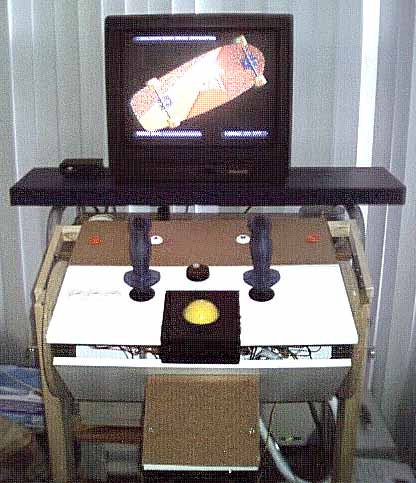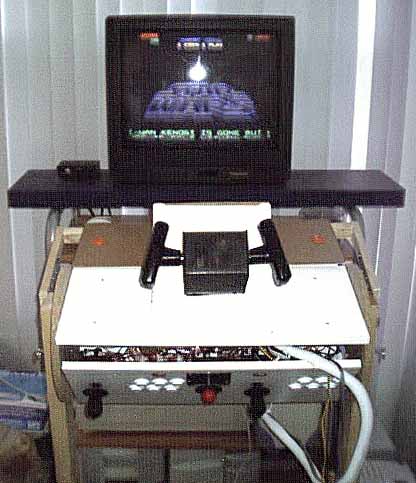 The
Concept Prototype The
Concept Prototype 
The
concept of Pac-Mamea was to build a true multi-game system, capable of using
a wide range of controls. I wanted to be able to play all my favorite
games without making sacrifices, such as having to play Tempest or Star Wars
with a joystick. I wanted balltop sticks, fighter sticks, flight
sticks, spinners, trackballs, and an analog yoke control.
I also knew
that I wanted to have a machine that looked nice. So I had to devise a
way that I could have all those controls, without destroying the design with
one big, cluttered "Franken-panel". I had heard about people
who had used removable, or swappable control panels, but living in an
apartment, storage space for extra panels was out of the question.
So I hit on the
idea of a 3-sided, rotating control console. I quickly put together a
wooden prototype to test the concept, which you can see in the following,
low quality photos.... The commentary below was written at the time
the prototype was built, so many of the plans I had laid out were soon to
change.

Panel one is set up for classic 4-way
games and 6-button fighting games. The Ms. Pac-Man replacement stick fits into a
countersunk area on top of the panel, and the plate will be concealed by a
printed overlay and 1/16" Lexan. It is used for Pac-Man, Dragon's Lair, Street Fighter, etc.

Panel two is set up with a 3"
trackball, a Discs Of Tron-style up/down spinner, and two 8-way trigger joysticks.
The trackball enclosure is flush mounted, and will be concealed by a printed overlay and
1/16" Lexan. It can play games such as Tempest, Major Havoc, Missile Command,
Tron/Discs Of Tron, 720, and Battlezone.

Panel three is set up for analog flight
games. It features a genuine Star Wars yoke, refitted with new springs and
microswitches, interfaced thru a MS Dual Strike USB, and works EXACTLY like the original.
Not yet installed are the F-15 Talon analog flight stick, and a throttle control.
It is used for analog flight and racing games such as Star Wars, S.T.U.N. Runner
etc.
All buttons and joysticks are interfaced
thru a single 28-input I-Pac. In final form, the CP would fit entirely within the
cabinet, with the 2 unused panels concealed by the front access panel. The tan
extension in the back (with the start buttons) will be 50% shorter than it's shown, and it
hinges upward to allow the control changeover. The circular end plates lock into
position by hitch pins inserted thru the 2x4 side posts. Average changeover time
between panels on this configuration is under 10 seconds.
|
| The
information on this site is for the purposes of education and
entertainment only. The owner of this site makes no warantees as to
the accuracy of the information, and takes no responsibility for any
damage or injury sustained due to the use of information herein. The
design of the Pac-Mamea cabinet and all photos, computer renderings,
drawings, schematics, and printed information relating to such are
Copyright © 2002-2004 Robert Meyers. No ownership of other
copyrighted material found on this site is implied. |



